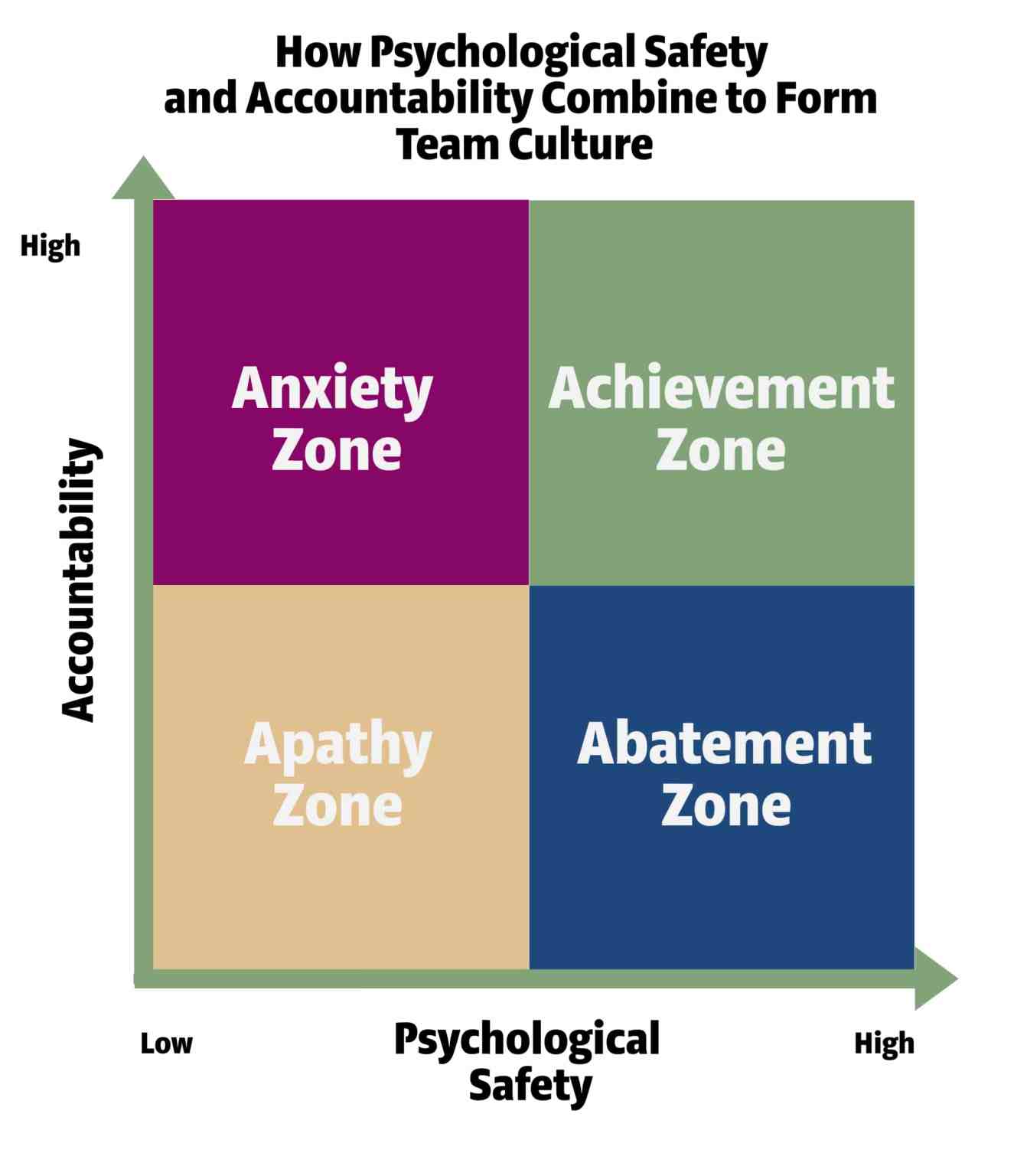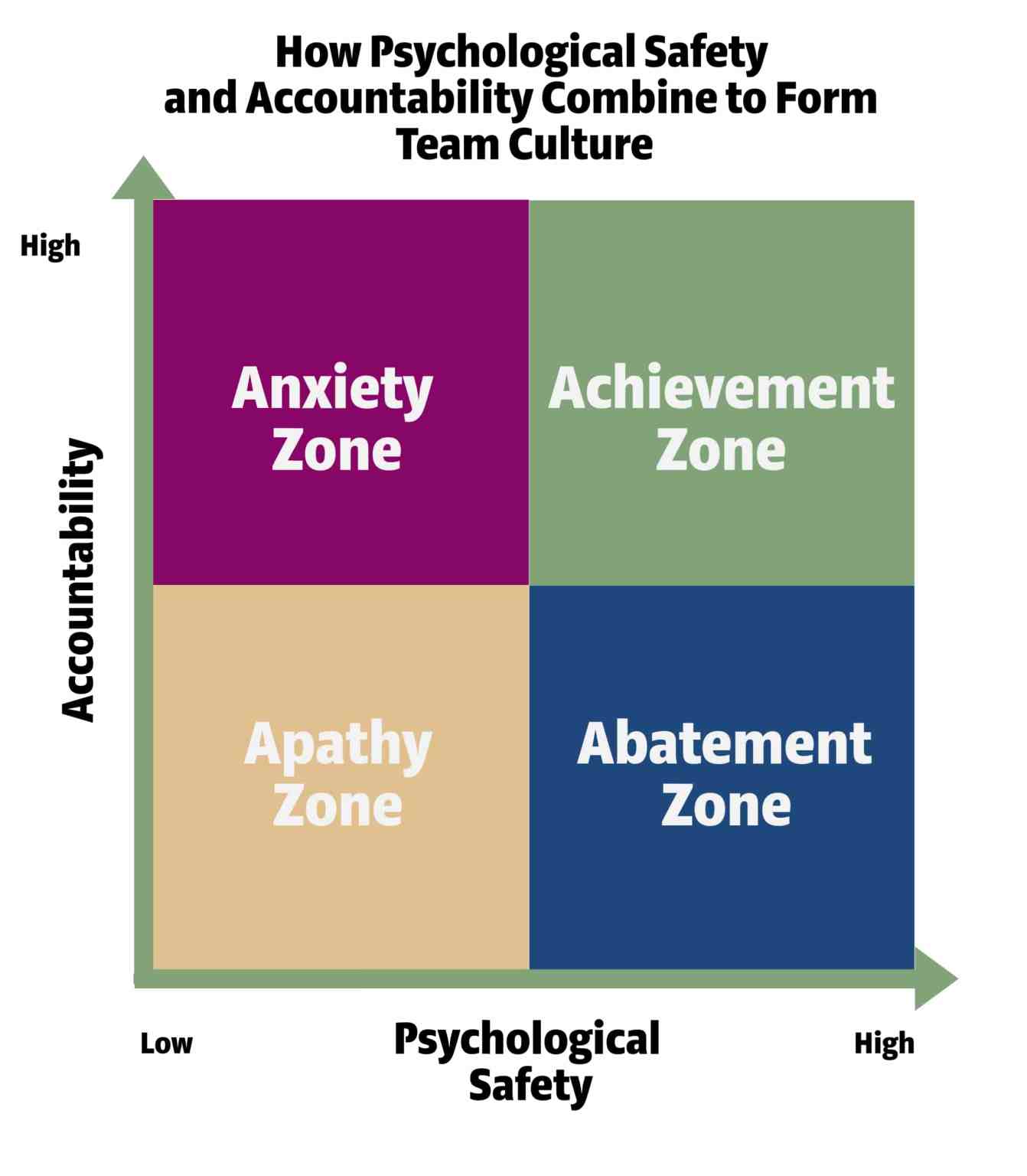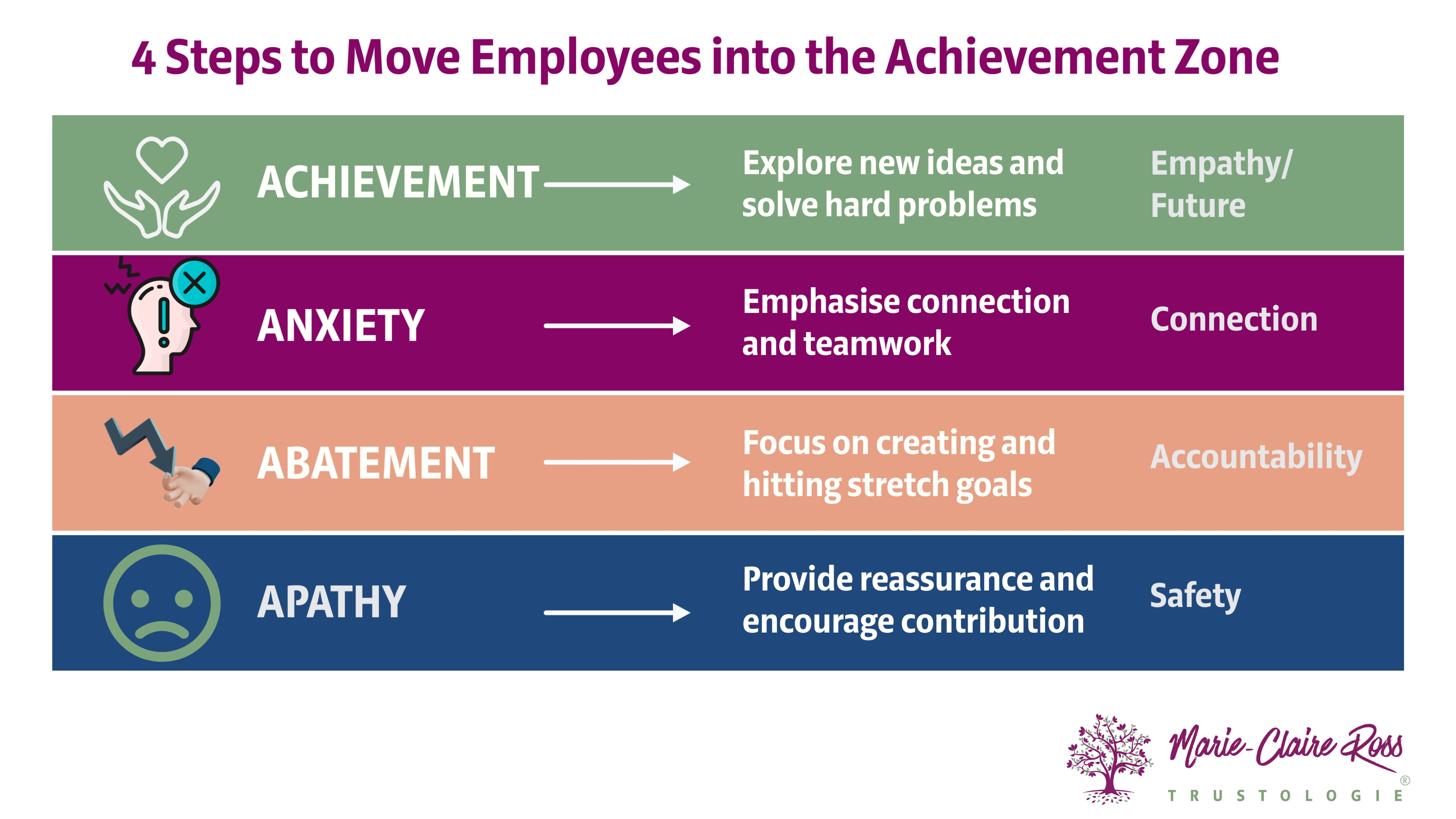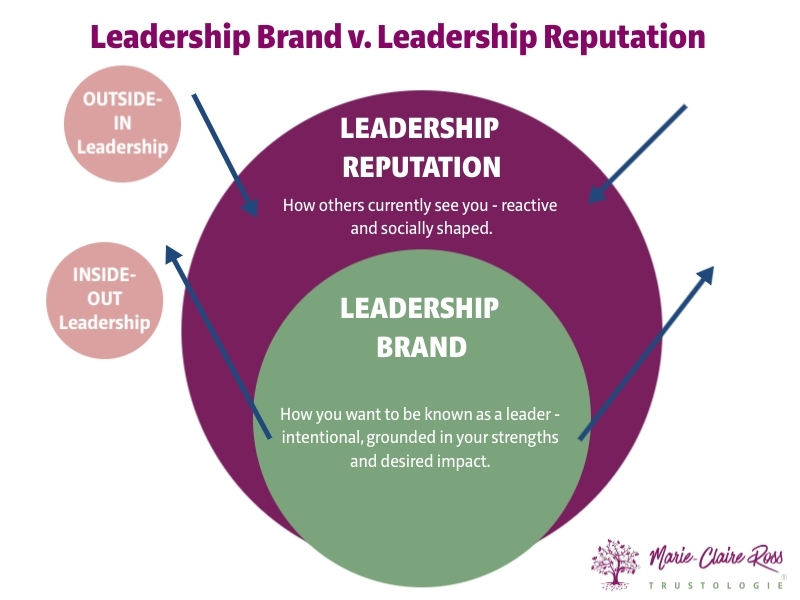6 Essential Executive Skills That Will Make You Unstoppable in 2026
The workplace is evolving at a pace few previous generations have seen and 2026 will mark a turning point. The Future of Work is blended, not hybrid....
Develop leaders, strengthen executive teams and gain deep insights with assessments designed to accelerate trust and performance.

Transform how your leaders think and perform with keynotes that spark connection, trust and high-performance cultures.

Explore practical tools, thought-leadership and resources to help you build trusted, high-performing teams.

Trustologie® is a leadership development consultancy founded by Marie-Claire Ross, specialising in helping executives and managers build high-trust, high-performing teams.

5 min read
Marie-Claire Ross : Updated on February 1, 2023

According to research by Dr Amy Edmondson, a Harvard Professor, a combination of psychological safety and high standards is vital for teams to reach their full potential.
Yet, it is a challenge for leaders to balance cultivating a friendly, warm team environment, with holding employees accountable in getting work done to the right standard.
As I mentioned in my book, Trusted to Thrive, the level of psychological safety and accountability in your team determines your team's culture and current level of performance.

Interestingly, these four zones also represent where we are currently performing and the impact that has on our teams. You might notice the zones also represent where individual team members are located.
Understanding how the intersection between safety and accountability impacts your team performance is a game changer for leaders. Knowing which zone team members are located in gives you important information on what strategies you can use during one-on-ones to lift their performance to the next team zone level.
Employees and teams move only through one stage at a time. Advancing someone from Apathy to Abatement is different from moving someone from Abatement to Anxiety. If you introduce Achievement zone tactics to someone in Abatement you will most likely fail.
So let's take a look at what things you can do to help your team members get through the zones quicker.

1. Moving out of the Apathy Zone
Individuals in the apathy zone feel alienated, depleted and cynical. All of their energy is spent on self-preservation - either because they are afraid of being caught out doing the wrong thing or they are exhausted.
There is a lot of blame and distrust of leadership in this zone. The key word to move people out of apathy is safety.
This requires providing reassurance that they are valued and encouraging contribution.
Think of it as being like rescuing a small kitten that has been abandoned. You find them hidden under a bush down a main road. They are grubby, skinny and one eye is closed. They are frightened, so they hiss and try to bite you. You decide to take them home, clean them up and get them checked over by a vet. In all of your interactions, you are gentle, caring and considerate. Within a few days, they can see that you aren't going to hurt them, so their hisses magically transform into little meows. They open up and feel comfortable in making bigger meows that let you know all of their problems. You listen - without judgement or blame and try and work out what they want.
Gradually, they seem more comfortable around you, so you start to teach them new things. Providing encouragement and reassurance that they are doing well. Each day they become more confident and happier.
That's what moving people out of the Apathy Zone is like. Usually they have gone through some sort of trauma at work - either through a boss that under-managed them or KPIs that were hard to achieve with outdated processes and equipment.
Introduce weekly check-ins where you help them see how their work has meaning and is valued by those around them. Regularly praise them when they do good work or exhibit the right behaviours. Concurrently, upgrade the safety in your team by not tolerating any negative behaviours towards others and seeking everyone's input in team meetings. Usually you will have more than one person in the Apathy Zone.
It will take a lot of dedicated work to turn this team around and it requires a lot of personal and team interactions to create safety.
2. Moving out of the Abatement Zone
In the Abatement Zone, individuals have been able to coast for some time and evade accountability for work performance.
Moving people into a zone of high performance can be a shock to their system. It's a bit like they have been on a long summer holiday and now they are back at school and their head is spinning with all of the information they have to learn.
The key word to move out of Abatement is of course, accountability. The focus is on creating and hitting stretch goals.
Again, this involves weekly ons-on-one's so you can work closely with them to not only lift performance but show you are supporting them in their goals. Sit down with them and let them know you see their potential and want to help them.
According to a Gallup study, 61% of managers with high talent (at leading others) say they take a strengths-based approach, while fewer percentages of managers with functioning or limited talent say the same. In fact, Managers with limited talent are more likely than those with high and functioning talent to say they focus equally on employees' strengths and weaknesses.
Work out both their personal and work goals. Let him know how their work makes an impact on those around them and the team's purpose. Talk about their strengths and capabilities that are not yet developed (being mindful of your tone).
Assign a small project that they can excel in a short duration. Schedule check in points so that you can monitor their performance without being perceived as a micro manager. Demonstrate you are their accountability partner to support them in expanding their capabilities and skills.
3. Moving out of the Anxiety Zone
Anxiety Zone employees are hard workers that are keen to reach goals. Often, they feel disconnected and all alone in doing the work. This becomes a vicious cycle where they often feel they can only rely on themselves.
The key focus word here is connection. The strategy to do this is to emphasise connection and teamwork.
In your one-on-one's it's important to help them learn to ask for help (and accept it) and work with others. Help them with their work prioritisation to reduce overwhelm. Bring in other resources and connections to help. Show her that she doesn't have to do it all on her own. Tell her how smart she is and reassure her that you are there to support her. Help her see you are an ally to removing the constant pressure she feels.
The goal here is helping her understand that she can make a bigger impact with others, than alone. Help her understand that the more the team succeeds, the more she succeeds. Work on the team to improve interactions and use "we" rather than "I" language.
4. Staying in the Achievement Zone
Keeping ourselves in the Achievement Zone is not easy. We need to be intentional and always working on it.
To help our direct reports play in this zone for longer, the key themes here are empathy and future. This involves taking the time for them to understand each of your direct reports, individual goals and aspirations, so that you can explore new ideas and solve hard problems.
This occurs when a team leader creates stretch goals and challenges direct reports to improve and strongly believes they can achieve. A lot of leaders approve small incremental improvements to goals. This might be necessary in the Apathy or Abatement Zones, but here you can really expand people's beliefs in what they can achieve. In this zone, you can treat employees like athletes pushing them to continually improve – breaking their best records, not by a few degrees but through dramatic improvement.
Achievement zone leaders foster a supportive environment where employees learn and work together, focus on continuous improvement and explore exciting new possibilities. After all, people tend to not spontaneously stretch themselves, but need the support of a leader who fosters the right environment to grow and learn. In this environment, people thrive on the autonomy to work how they want and contribute to high level decisions.
The Achievement Zone team only occurs when the leader leads by example and works hard to ensure they are trusted by the team and encourages team members to trust one another. It involves envisioning a positive future that you can articulate clearly so that people know their effort is worth it, encouraging continuous improvement, new ideas and making failing part of work.
Leading your team into the Achievement zone requires a range of techniques to ensure that your direct reports see you as authentic. That you demand the best from them, as well as yourself. At its core, it means you are excited about the future - new ideas and doing things differently. Continually learning and growing.
It's not easy to do this alone. In fact, it's quite exhausting to be the one always inspiring and challenging others. The question is: who is supporting and encouraging you?
If you want to be in a supportive environment and learn with others on what you can do to try new techniques and improve the momentum of your team, sign up for my free webinar, 3 Indispensable Secrets to Leading Thriving, Capable Teams. It's on next week.

The workplace is evolving at a pace few previous generations have seen and 2026 will mark a turning point. The Future of Work is blended, not hybrid....

Many leaders jump into a leadership position excited by the opportunity to help others and perform at a higher level.

What makes a good team leader isn’t just about having authority or getting tasks done - it’s about the ability to create an environment where people...
-1.jpg)
If we want to lead our teams into the achievement zone, we need to lead ourselves there first.

According to the recent global Pulse of Talent report, by the HR tech firm Ceridian, 9 in 10 middle managers have experienced burnout over the past...

Leaders who help each of their employees feel valued for their contribution, supported to achieve challenging goals and clear on what they need to...